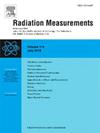基于深度学习的轨迹检测技术在中子个人剂量监测研究中的应用
IF 2.2
3区 物理与天体物理
Q2 NUCLEAR SCIENCE & TECHNOLOGY
引用次数: 0
摘要
本研究介绍了使用深度学习算法的目标检测范式(Faster R-CNN)在快中子轨道检测中的应用。使用CR-39探测器进行中子剂量测量,并评估两种方法-基于形态学特征的检测和深度学习(Faster R-CNN)。深度学习方法显示出优越的准确性,特别是在识别小轨迹和杂质点方面,达到了98.7%的正确率。此外,与人工和基于形态学特征的方法相比,该方法显著提高了检测速度。采用深度学习方法的中子个人剂量测定系统的性能通过线性验证、变异系数分析和剂量验证进行了验证。由于其完全自动化的性质,该方法可以降低测量的不确定度,并可以扩展到识别其他类型的粒子轨迹。本文章由计算机程序翻译,如有差异,请以英文原文为准。
Application of deep learning-based track detection technique in neutron personal dose monitoring research
This study introduces the application of the object detection paradigm (Faster R-CNN) to fast neutron track detection using deep learning algorithms. Neutron dose measurements were conducted using CR-39 detectors, and two methods-morphological features-based detection and deep learning (Faster R-CNN) were evaluated. The deep learning method demonstrated superior accuracy, particularly in identifying small tracks and impurity points, achieving a correct-count rate of 98.7 %. Additionally, it significantly improved detection speed compared to manual and morphological feature-based methods. The performance of the neutron personal dosimetry system, which incorporates the deep learning approach, was validated through linearity validation, coefficient of variation analysis, and dose verification. Due to its fully automated nature, this method can reduce measurement uncertainty and can be extended to recognize other types of particle tracks.
求助全文
通过发布文献求助,成功后即可免费获取论文全文。
去求助
来源期刊

Radiation Measurements
工程技术-核科学技术
CiteScore
4.10
自引率
20.00%
发文量
116
审稿时长
48 days
期刊介绍:
The journal seeks to publish papers that present advances in the following areas: spontaneous and stimulated luminescence (including scintillating materials, thermoluminescence, and optically stimulated luminescence); electron spin resonance of natural and synthetic materials; the physics, design and performance of radiation measurements (including computational modelling such as electronic transport simulations); the novel basic aspects of radiation measurement in medical physics. Studies of energy-transfer phenomena, track physics and microdosimetry are also of interest to the journal.
Applications relevant to the journal, particularly where they present novel detection techniques, novel analytical approaches or novel materials, include: personal dosimetry (including dosimetric quantities, active/electronic and passive monitoring techniques for photon, neutron and charged-particle exposures); environmental dosimetry (including methodological advances and predictive models related to radon, but generally excluding local survey results of radon where the main aim is to establish the radiation risk to populations); cosmic and high-energy radiation measurements (including dosimetry, space radiation effects, and single event upsets); dosimetry-based archaeological and Quaternary dating; dosimetry-based approaches to thermochronometry; accident and retrospective dosimetry (including activation detectors), and dosimetry and measurements related to medical applications.
 求助内容:
求助内容: 应助结果提醒方式:
应助结果提醒方式:


